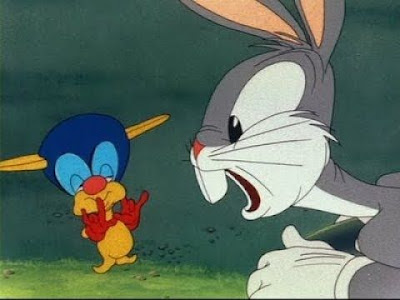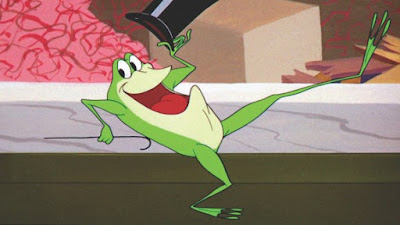Thanks to HBO Max, subscribers now have access to a plethora of classic Looney Tunes cartoons from the Warner Bros animation library. And with the anticipated Space Jam: A New Legacy (the long-awaited, Lebron James-led sequel to 1996's hit live-action/animated basketball comedy starring Michael Jordan) coming out this summer, let's recap on some of the most unforgettable shorts starring Bugs Bunny, Daffy Duck, Porky Pig and company, which should be required viewing for any die-hard animation geek (and with discretion, mind you).
WRITER'S NOTE: Times being what they are now, this library is a good excuse to remember the cartoons that made us laugh growing up, as well as a legacy of humor, creativity, and generation-bridging. Again, none of this is without any outdated insensitivities or unawareness of cartoon violence, lest we forget.
The following selected twenty shorts represent a portion of what should be some of the greatest Looney Tunes cartoons ever made:
You Ought to Be in Pictures (1940)
One of the first instances of live-action and animation merging together, as Porky Pig (pursuaded by an early, and zany, iteration of Daffy Duck) leaves his cel animation post to pursue a career in motion pictures, much to the doubt of real-life producer Leon Schleisinger (who makes a live-action appearance). Filmed in superb black-&-white.
The Wacky Wabbit (1942)
One of my earliest memories of Bugs Bunny, thanks to a VHS tape my grade school teachers gave me as a child. This Bob Clampett short, in which an earlier incarnation of Elmer Fudd digs for gold in the Old West, finds the "swewy wabbit" throwing hysterical hijinks at every turn. A hallmark of outrageous comedy.
A Tale of Two Kitties (1942)
Another Clampett classic, featuring a debut appearance by Tweety Bird, who faces off against feline caricatures of comedians Bud Abbott & Lou Costello. "TURN OUT THOSE LIGHTS!"
The Case of the Missing Hair (1942)
In one of director Chuck Jones' earliest screen efforts, Bugs matches wits with a snooty magician, quick-witted and wise-cracking as the smart-alack rabbit is. Notice the use of bright color and character exaggerations. This was also one of the first instances where Bugs echoed Groucho Marx with the unforgettable trademark, "Of course you know this means war."
Porky Pig's Feat (1943)
Daffy & Porky are stuck in a hotel, unable to pay a hefty bill to a pompous manager. Wacky characterizations (especially down an endless flight of stairs and between two skyscrapers), plus a brilliant fourth wall gag, hold this zany comedy together.
Falling Hare (1943)
Bugs meets his match against a WWII gremlin, in a rare case of being on the receiving end of the joke. And this was only four decades before Warner Bros made the classic Eighties movie directed by Looney Tunes fan Joe Dante.
Baseball Bugs (1946)
In this Friz Freleng-directed short, it's one baseball team against the one and only Bugs Bunny, whose quick wits and quips knock it out of the park, both literally and uproariously.
Hair-Raising Hare (1946)
Bugs tries to outwit a Frankenstein-esque monster in a haunted house. More importantly, this short features what may be the single greatest fourth wall gag in history! No contest.
High Diving Hare (1949)
One of Yosemite Sam's most hysterical showcases involves a high-diving match between the screw-loose gunslinger and Bugs Bunny. Belly laughs, through and through, even though this would not be made today.
Long-Haired Rabbit (1949)
Bugs poses as famed 20th-century conductor Leopold Stokowski while orchestrating an egotistical tenor through an incredibly-long aria, which literally brings the house down. You'll laugh your guts out.
Rabbit of Seville (1950)
Elmer Fudd's latest pursuit of the "swewy wabbit" becomes an unexpected, tables-turning operatic stage performance of "The Barber of Seville". A visual and aural riot.
Canned Feud (1951)
In this Friz Freleng-directed short, Sylvester the cat squares off against a smart-alack mouse for a can opener.
Putty Tat Trouble (1951)
Friz Freleng directed another winner with this fast-paced short, in which Tweety Bird is chased by two competing felines (one of them being Sylvester) during the winter. The result is slapstick gold.
Rabbit Fire (1951)
One installment in a trilogy of "Hunting" hijinks between Elmer Fudd, Bugs and Daffy (1952's Rabbit Seasoning is also comedy gold) is a brilliant showcase for Mel Blanc's versatile voice talents. Just listen to him as Bugs and Daffy imitate each other! "Shh. Be ve-wy, ve-wy quiet. We're hunting Elmers." This is another short that could never be made today.
Feed the Kitty (1952)
Marc Anthony the bulldog becomes enamored with a little kitten, and constantly tries to hide it from his strict owner. One of Chuck Jones' best and most beloved shorts.
Duck Amuck (1953)
Perhaps the ultimate meta cartoon, in which an unnamed animator constantly changes the scenery of Daffy Duck's latest short, need we say more.
Duck Dodgers in the 24-1/2-th Century (1953)
One of the best pairings of Daffy Duck (as the unforgettable galactic superhero) & Porky Pig (as his dimwitted, straight-man sidekick), and one of Marvin the Martian's finest hours.
Devil May-Hair (1954)
The wild and crazy debut of the wild and crazy Tazmanian Devil. Enough said.
One Froggy Evening (1955)
The debut of Michigan J. Frog (long before he became the short-term mascot for the WB network) is a classic piece of visual and aural comedy. This may be the default showcase for classic ragtime tunes.
What's Opera, Doc? (1957)
Considered by many animation critics and historians as the single greatest cartoon in the history of Looney Tunes, Elmer Fudd and Bugs interpret the hunter's typical shtick by way of a full-blown opera. Incredible attention to detail not only in the art direction, but also in the absurd, caricatured and brilliant character animation.
***
Other standout Looney Tunes (or related) animation (from the late-Eighties, early-Nineties, and recent years) that are worth noting:
Other standout Looney Tunes (or related) animation (from the late-Eighties, early-Nineties, and recent years) that are worth noting:
Cameo appearances in 1988's Who Framed Roger Rabbit, which was also one of the last cinematic vocal contributions from the late Mel Blanc. (Don't worry, that's not all, folks.)
The prologue and epilogue shorts in 1990's Gremlins 2: The New Batch, in celebration of Bugs' 50th anniversary.
The animated Chuck Jones short at the beginning of 1993's Mrs. Doubtfire.
The 1994 short Chariots of Fur, starring the Road Runner and Wile E. Coyote.
The 1996 short Superior Duck, an homage, of sorts, to Duck Amuck, in terms of fourth wall humor and interactions between Daffy and the mysterious narrator (in this case, the late Thurl Ravenscroft).
Bugs Bunny as the "Warner Bros Family Entertainment" mascot.
Marvin the Martian's blink-and-you'll-miss-it "cameo" in 2013's Gravity.
The recent Warner Brothers Animation logo, featuring Daffy Duck in his early wacky form.


































No comments:
Post a Comment